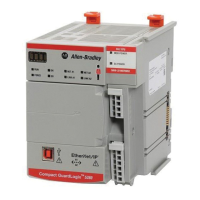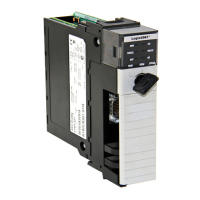Behavior models used in CIP Motion
Rockwell Automation Publication MOTION-RM003I-EN-P - February 2018 31
The following table provide a reference to the polynomial equations:
Interpolator name Equation
Position Fine Interpolation Polynomial P(t) = a
0
+ a
1
* (t-t
0
) + a
2
* (t- t
0
)
2
+ a
3
* (t-t
0
)
3
Velocity Fine Interpolation Polynomial V(t) = b
0
+ b
1
* (t-t
0
) + b
2
* (t- t
0
)
2
Acceleration Fine Interpolation Polynomial
A(t) = c
0
+ c
1
* (t-t
0
)
Torque Fine Interpolation Polynomial T(t) = d
0
+ d
1
* (t-t
0
)
In these equations, time (t
0
), represents the Command Target Time for the
previous Motion Planner update such that when t = t
0
, the position (P), velocity
(V), acceleration (A), and torque (T) command values are equal to the values sent
in the previous Motion Planner update, for example, P
–1
, V
–1
, A
–1
, and T
–1
. This
establishes the 0
th
order coefficients of the polynomials.
• P(t
0
) = P
–1
= a
0
• V(t
0
) = V
–1
= b
0
• A(t
0
) = A
–1
= c
0
• T(t
0
) = T
–1
= d
0
The higher order polynomial coefficients are calculated such that by the next
Motion Planner update, corresponding to Command Target Time, t
1
, the
position, velocity, acceleration, and torque command values are the values sent in
the latest Motion Planner update, for example, P
0
, V
0
, A
0
, and T
0
.
• P(t
1
) = P
0
• V(t
1
) = V
0
• A(t
1
) = A
0
• T(t
1
) = T
0
Using the above polynomial interpolation equations, the CIP Motion device can
compute position, velocity, acceleration, and torque command values at any time
by plugging in the current System Time value of the device into the variable, t.
This allows the device's control calculation to be performed according to a
schedule that is independent of the controller's update schedule.
One thing that must be done, however, is to adjust the Command Target Time, t
0
,
if there is a shift in the System Time Offset for the device; t
0
and t are always based
on the same System Time reference system. For example, assume the device's
System Time Offset when the control command timestamp, t
0
, was received as
Offset
0
. If the command interpolation equation is to be applied at t= t
1
and the
current System Time Offset is defined as Offset
1
, then t
0
is adjusted as follows
before executing the polynomial:
• Adjusted t
0
= t
0
+ (Offset
1
– Offset
0
)

